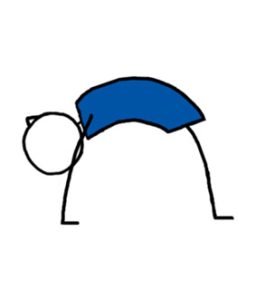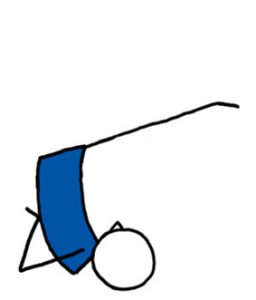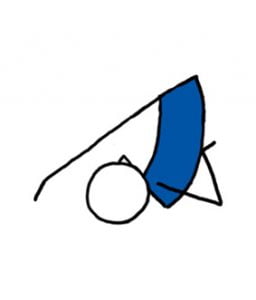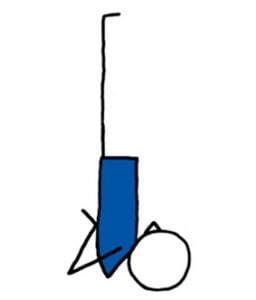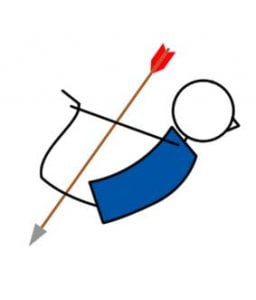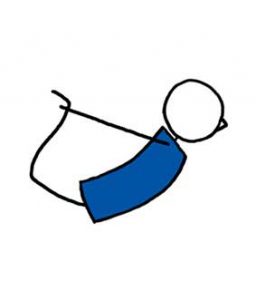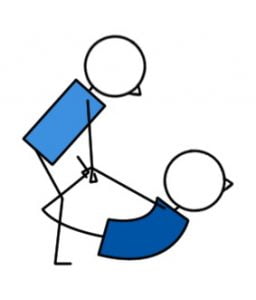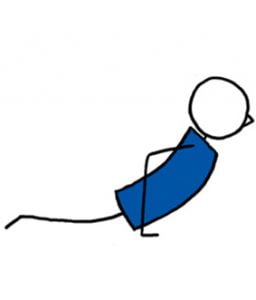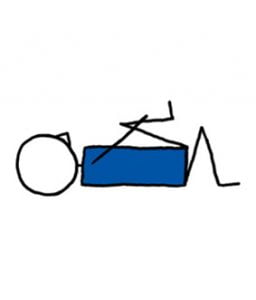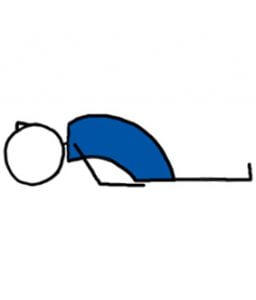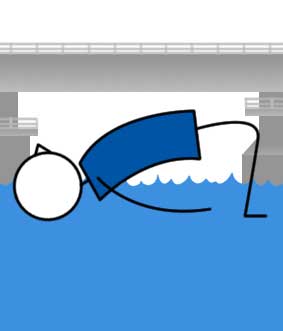
| Category: | Kids Yoga Planner |
|---|---|
| Sub Category: | Seated & Floor |
| Types: | Back Bend, Chest Opener, Hip Opener, Inversion, Object, Seated & Floor, Stretch, Supine |
| Anatomy: | Arms & Shoulders, Core, Hamstrings, Hips, Knees, Middle Back, Neck, Psoas |
| Chakras: | Crown Centre, Heart Centre, Solar Plexus Centre, Third Eye, Throat Centre |
| Therapy: | Back Pain, Confidence Building, Depression, Headaches, Herniated Disc, Indigestion, Leg Congestion, Poor Posture, Stress |
| Drishti: | Up |
| Dosha: | Pitta, Vata |
| Meridian Lines: | Bladder, Kidney, Spleen, Stomach |
Relationships connect people and so do bridges. Let's build a People Bridge that connects everyone as one. Lie down on your back. Bend knees. Spread knees a little bit apart. Press into feet. Lift up your bottom. Interlock hands. You're now a People Bridge that is connecting with everyone in this room and on Planet Earth. Let's raise the bridge so a large boat can pass. Lift one leg to the sky to raise the bridge, and then the other.
Chest, neck, and spine stretch.
A) Baby Bridge (raise up to a comfortable position). B) Bridge with a blanket under shoulders. C) Bridge with leg up. D) Clasp hands around ankles. E) Block below shoulders. F) Block, or bolster, below the lower back. G) Feet close to a wall to prevent slipping.
Knee or neck injury.
Click here for lots of FREE downloadable Yoga lesson plans.
Click here for lots of FREE downloadable Pilates lesson plans.
Bridge Pose For Kids FAQs
What is the Sanskrit for Bridge pose?
Setu Bandha Sarvangasana (SEY-tu-BAHN-duh sahr-vahng-GAHS-ah-nuh)
In Sanskrit, Setu is “bridge,” Sarva is “all,” and Anga is “limb.” In Setu Bandha Sarvangasana, the pose you make with your body uses all your limbs to create a bridge. Make a mental picture of a bridge over tranquil water as you breathe deep and raise your bridge.
What is Bridge pose also known as?
Bridge pose is also known as Dwi Pada Pitham, Setubandha Sarvangasana, Setu Bandhasana, Kandhrasana, Dwi Pada Pitham, Shoulder Pose, and Two-Legged Table.
What are the Bridge pose teaching steps?
Lie supine. Bend knees. Set feet on the floor. Heels close to sitting bones. Press inner feet and arms into the floor. Push tailbone up. Lift buttocks. Place hands under hips. Raise left leg. Hold. Lower left leg. Repeat with the right leg. Release hands. Lower slowly to mat.
What are some Bridge pose modifications?
Adding some of the modifications below turns Bridge pose into a great workout – all without standing up!
A) Bridge pose with a blanket under the shoulders.
B) Bridge pose with a block below the shoulders.
C) Bridge pose with a block (or bolster) below the lower back bringing the back of the crown of the head to the mat.
D) Bridge pose with feet close to a wall to prevent slipping.
E) Bridge pose with one leg raised.
F) Bridge pose with arms behind.
G) Bridge pose with the ankle on a knee.
H) Bridge pose with hands placed on hips.
I) Bridge pose on your head (advanced).
J) Bridge pose with a partner (partner yoga).
K) Bridge pose with a block between the thighs.
What are some good gentle backends to use as preparation poses?
A) Cat-Cow pose
B) Cobra pose
C) Sphinx pose
What’s a good counter pose?
Most yoga teachers will get their students in the Knees To Chest pose, or Knees To Head pose after they’ve completed the Bridge pose.
Can I use Bridge pose as a resting pose?
Yes. This “go-to” backbend can be performed restoratively (a resting Yin pose) or dynamically (a Yang strengthener).
How can I use the Bridge pose as the theme for my yoga lesson plan?
The pose you make with your body uses all your limbs to create a bridge. So, the obvious theme is “Building A Bridge”. You could ask your students, when they are in the pose, to make a mental picture of a bridge over tranquil water as they breathe deep while raising their bridge.
Also, any of the “10 benefits” below can be turned into the theme for your yoga class (e.g. posture perfect theme).
What are the benefits of backend postures?
Any of the 10 “benefits” below can be turned into the theme for your yoga class (e.g. “posture perfect” theme).
Benefit 1: Posture Perfect
If you work a job where you are sitting most of the time, it is likely that your posture is hunched (unless you are aware of your posture and correct it). People also hunch when they are looking at their cell phones – next time you go out, watch someone as they text or play on their phone. Their shoulders will often be hunched, and their neck protruded forward. Backbends help counteract the damage of bad posture by bending the spine in a direction it isn’t used to. They help to realign our vertebrae while at the same time stimulating the sympathetic nervous system. They open the chest, lengthen the spine, and strengthen the upper back, all of which make our posture more straight.
Benefit 2: Shoulder Opener
Backbends are great for helping open shoulders – an area where most of us hold tension. Most people have shoulders that are rolled in, and a head that is cranked forward – this makes our breathing shallow and lungs compressed, making us feel less than optimal. Practising backbends will crack open this area, and subconsciously encourage rolled-back shoulders.
Benefit 3: Hip Flexor Stretch
The hip flexors are the muscles that allow us to lift our knees and bend at the waist. They’re found deep in the abdominal cavity, and cause pain for many individuals (especially if you are a runner or bicyclist). The pain is often felt in the upper groin region where the thigh meets the pelvis. Backbends are great hip flexor openers, as they extend the hips and give these muscles a chance to stretch. Be careful, however, as tight hip flexors can make backbends a little difficult, and may require other hip-opening exercises beforehand to get the really deep hip stretch that backbends will give.
Benefit 4: Brain Health
Chronic back pain, which can be restored through backbends, has been linked to lowering grey matter in the brain. Take your brain to the spa with a backbend.
Benefit 5: Back Strengthener
You can easily gain spinal strength with the help of backbends. I’ve been practising for almost two years and I’ve noticed a huge difference in how much stronger my back is. Backbends require lifting the body against the force of gravity, which helps build strength. Cobra pose, Camel pose, King Pigeon pose, Upward-Facing Dog pose, and Bridge pose are all backbends and fab spine-strengtheners.
Benefit 6: Back Pain Buster
If your back hurts practice gentle backbends. Our back is often in a state of chronic pain because we spend so much time bending forward, and not backward. When we start practising backbends, we counteract the impact of continuous forward bending and ease stress on parts of the spine that are often stuck in the chronic forward position. This will also help you stand straighter, which again, is another reason so many people experience back pain.
Benefit 7: Heart Chakra Awakener
Backbending opens up the chest (heart space), which is connected to our sense of well-being and connection with others. Many people get emotional when they do a deep backbend (like the Cobra pose, Camel pose, King Pigeon pose, Upward-Facing Dog pose, or Bridge pose). Whether you’re flexible or not, you may experience a tsunami of different emotions when first learning how to bend your back. One of the deepest lessons in the yoga practice is about bringing energy up the spine and cleansing the nervous system. Backbends thrust your full life force up through this central channel and burn through blockages along the way. When one of these blockages gets triggered it really does not matter whether you are doing a deep backbend or a beginner backbend, because the emotional state that gets triggered is really of paramount importance. Don’t run away when things get tough and emotional – backbends are an amazing thing you can do for your body and will make you a stronger individual both mentally and physically. Remember to breathe through it.
Benefit 8: Breath Mastery
Backbends help open the shoulders and chest, getting rid of the tension that cramps our lungs and makes breathing shallow and uneasy. Once our chest starts to open, there is more space created for our lungs, allowing for deeper breathing and thus more oxygen flow through the body (this translates to better mental and cardiovascular function).
Benefit 9: Energy Elixir
Backbending is a great way to give yourself a boost of energy. If you’ve ever done a backbend, then you’ve felt that rush of energy that invigorates the whole body. Your breath feels deeper and your sense of awareness sharpens. Backbending helps stimulate all chakras in the body and clears energetic blocks that make way for a huge boost of energy – not only that, but they increase our breathing ability, and breathing is key to truly embracing the life force that makes us feel alive.
Benefit 10: Fear Blocker
Many people fear backbends, especially intense ones like the King Pigeon pose, Upward-Facing Dog pose, and Bridge pose that make us move outside of our comfort zone. However, once you step out of that zone, you’ll really start to notice the change. Facing our fears and coming face-to-face against our physical edge teaches us to develop patience – especially with back bending when we are forced to form a deep trust with ourselves.




 Yoga Lesson Planner
Yoga Lesson Planner
 Pilates Lesson Planner
Pilates Lesson Planner
